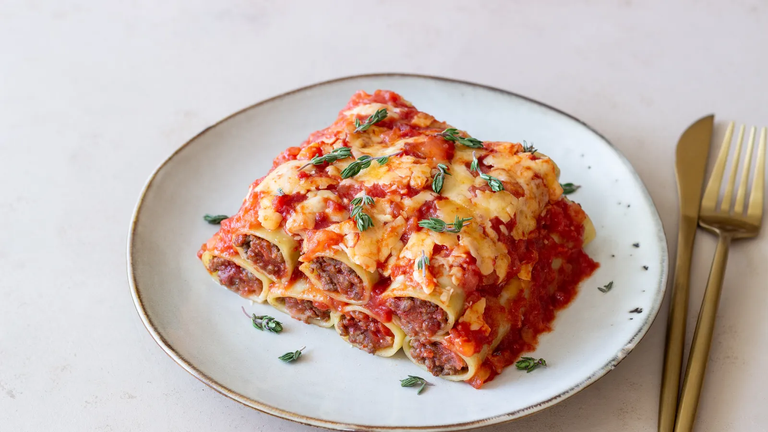
Perfect for Sunday family lunches, meat cannelloni have always been loved and appreciated. It is no coincidence that it is said that this type of pasta has always been among the best known: in the central regions of Italy and in Emilia, it was customary to form rectangles of dough that were then stuffed with meat or vegetables and rolled up. Even today, cannelloni are made with a mixture of flour and eggs that is then rolled out into small sheets, stuffed with various fillings, meat and more.
The pasta is then covered with a tomato sauce and plenty of Parmigiano Reggiano, and cooked in the oven until the surface becomes golden and crispy. Like many other stuffed pastas, meat cannelloni also acquire more flavor if eaten the day after preparation.

Perfectos para los almuerzos familiares de los domingos, los canelones de carne siempre han sido amados y apreciados. No es casualidad que se diga que este tipo de pasta siempre ha estado entre las más conocidas: en las regiones centrales de Italia y en Emilia, era costumbre formar rectángulos de masa que luego se rellenaban con carne o verduras y se enrollaban sobre sí mismos. Incluso hoy en día, los canelones se hacen con una mezcla de harina y huevos que luego se extiende en pequeñas láminas y se rellena con diversos rellenos, entre ellos carne y más.
Luego la pasta se cubre con una salsa de tomate y abundante Parmigiano Reggiano y se cocina en el horno hasta que la superficie quede dorada y crujiente. Como muchas otras pastas rellenas, los canelones de carne también adquieren más sabor si se comen al día siguiente de su preparación.
Recipe for 6 people / Receta para personas n. 6

- 500 g flour (or 12 ready-to-use cannelloni)
- 4 eggs
- 40 ml extra virgin olive oil
- 20 ml water
- a pinch of salt

- 500 g de harina (o 12 canelones listos para usar)
- 4 huevos
- 40 ml de aceite de oliva virgen extra
- 20 ml de agua
- una pizca de sal

60' + 20' cooking time / 60' + 20' de cocción
- Carefully mix all the ingredients and when a ball forms that comes away from the edges of the bowl, it means it's ready.
- After placing it on a floured surface, work it by hand, collecting the flour.
- The consistency should be similar to that of an earlobe.
- Cover it with cling film for an hour and let it rest outside the fridge.
- After this time, spread it on a floured surface until it is about the thickness of a finger.
- At this point, after having cleaned them well, boil the spinach in a little salted water.
- If you use frozen pasta, follow the manufacturer's instructions.
- Drain them and when they are lukewarm, drain them well so that they are dry and cut them into pieces.
- Then mix them in a bowl with the ricotta, parmesan, salt, pepper and nutmeg.
- On a floured surface, spread the dough into a thin sheet (about 1 mm thick), cut it into small rectangles of approximately 10 x 7 cm.
- Now take a saucepan, fill it up to 3/4 of its capacity with lightly salted water, put it on the heat and when the water starts to boil, boil the ready-to-use pasta or cannelloni rectangles for a few minutes.
- Drain them when they are still very al dente and immerse them in a bowl full of ice water to cool them, then let them dry on a kitchen towel without overlapping them because they would stick together.
Using a pastry bag, place a little of the filling on each of these and, if you are using homemade cannelloni, roll them up and place them in a buttered baking dish. - Cover with the bechamel sauce (see below) in which we have diluted the white truffle paste, sprinkle with grated parmesan and a few flakes of butter here and there and bake at 200° for about 15 minutes.
We remind you how to prepare the bechamel sauce (for 6 people):
1/2 litre of milk, 2 tablespoons of flour (50 gr.), 2 tablespoons of butter (50 gr.), salt, a pinch of pepper, grated nutmeg.
Preparation: Blend the milk with the flour, salt, pepper and nutmeg. Pour it into a saucepan where the butter has been melted over a low heat. Bring to the boil, stirring constantly with a wooden spoon. After about 3 minutes of boiling the sauce will have thickened and is ready to use.)

- Mezcla con cuidado todos los ingredientes y cuando se forme una bola que se despegue de los bordes del bol significa que está listo.
- Luego de colocarla sobre una superficie enharinada, trabajarla manualmente, recogiendo la harina.
- La consistencia debe ser similar a la del lóbulo de la oreja.
- Cúbrelo con film transparente durante una hora y déjalo reposar fuera del frigorífico.
- Pasado este tiempo, extiéndela sobre una superficie enharinada hasta que tenga el grosor de un dedo aproximadamente.
- En este punto, después de haberlas limpiado bien, ponemos a hervir las espinacas en un poco de agua con sal.
- Si utiliza congelados, siga las instrucciones del fabricante.
- Escurrirlas y cuando estén tibias escurrirlas bien para que queden bien secas y trocearlas.
- Luego mézclalos en un bol con la ricota, el parmesano, la sal, la pimienta y la nuez moscada.
- Sobre una superficie enharinada, extiende la masa en una lámina fina (de aproximadamente 1 mm de espesor), córtala en pequeños rectángulos de aproximadamente 10 x 7 cm.
- Ahora cogemos una cacerola, la llenamos hasta 3/4 de su capacidad con agua ligeramente salada, la ponemos al fuego y cuando el agua empiece a hervir, ponemos a hervir durante unos minutos los rectángulos de pasta o canelones listos para usar.
- Escurrirlos cuando aún estén muy al dente y sumergirlos en un bol lleno de agua helada para enfriarlos, luego dejarlos secar sobre un paño de cocina sin superponerlos porque se pegarían.
- Sobre cada uno de estos, con ayuda de una manga pastelera, coloca un poco del relleno y si utilizas canelones caseros, enrollalos y colócalos en una fuente de horno untada con mantequilla.
- Cubrir con la salsa bechamel (ver más abajo) en la que hemos diluido la pasta de trufa blanca, espolvorear con parmesano rallado y unas copos de mantequilla aquí y allá y hornear a 200° durante unos 15 minutos.
- Les recordamos cómo preparar la salsa bechamel (para 6 personas) :
- 1/2 litro de leche, 2 cucharadas de harina (50 gr.), 2 cucharadas de mantequilla (50 gr.), sal, una pizca de pimienta, nuez moscada rallada.
Preparación: Licuar la leche con la harina, la sal, la pimienta y la nuez moscada. Verterla en una cacerola donde se ha puesto a derretir la mantequilla a fuego lento. Llevar a ebullición removiendo constantemente con una cuchara de madera. Después de unos 3 minutos de ebullición la salsa habrá espesado y estará lista para usar)
A brief introduction to cannelloni. / Una breve introducción a los canelones.
Cannelloni are a cylindrical-shaped pasta. The product is usually eaten with a savoury filling that can include cheese, ricotta, spinach and minced meat. It is then covered with a classic tomato sauce or béchamel sauce and baked in the oven.
In the Marche region of southern Italy, cannelloni are a type of fresh egg pasta. The typical filling is made from a mixture of minced meat and is always cooked in the oven. This type of pasta is sold both in the pre-cooked version and in the one that requires boiling before filling. The dimensions are approximately 8 to 10 cm long and about 2 in diameter.

s canelones son una pasta con forma cilíndrica. El producto se suele consumir con un relleno salado que puede incluir queso, ricotta, espinacas y carne picada. Luego se cubre con una salsa de tomate clásica o con salsa bechamel y se cocina al horno.
la región de Marcas en la Italia meridional, los canelones son un tipo de pasta fresca al huevo. El relleno típico está hecho de una mezcla de carne picada y se cocina siempre en el horno. Este tipo de pasta se comercializa tanto en la versión precocida como en la que requiere hervir antes de rellenarla. Las dimensiones son aproximadamente de 8 a 10 cm de largo y unos 2 de diámetro.
These recipes and many others published in # BLURT can be found on my blogs in Italian, English and Spanish. More than 5,000 recipes to give fantasy and color to your table and make a figure worthy of a chef with your guests.

Estas recetas y tantas otras publicadas en #BLURT las pueden encontrar en mis blogs en italiano, inglés y español. Más de 5.000 recetas para darle fantasía y color a tu mesa y hacer una figura digna de un/a chefs con tus invitados.


Y como siempre me despido de todos con un:
And as always I bid you all farewell with a:
